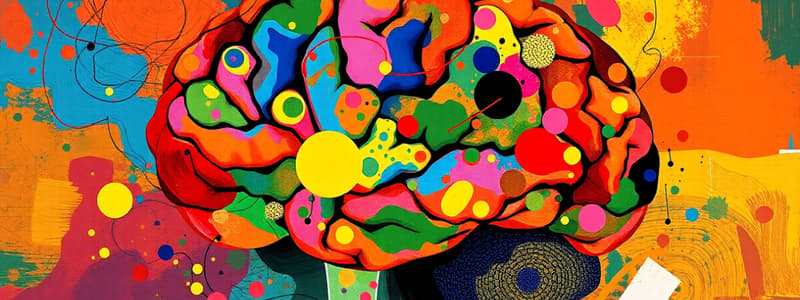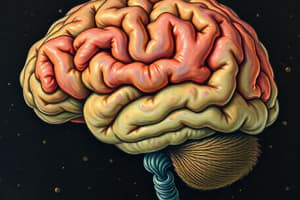Podcast
Questions and Answers
The sensorimotor cortex is subdivided into four areas designated by the letters Ms and Sm, with the capital letter indicating the predominant association, either motor or sensory.
The sensorimotor cortex is subdivided into four areas designated by the letters Ms and Sm, with the capital letter indicating the predominant association, either motor or sensory.
True (A)
The supplementary motor area (MsII) is located within the postcentral gyrus.
The supplementary motor area (MsII) is located within the postcentral gyrus.
False (B)
Brodmann's areas 4 and 6 correspond to what is now known as Msl.
Brodmann's areas 4 and 6 correspond to what is now known as Msl.
True (A)
Area SmII is associated with Brodmann areas 4 and 6, representing higher-order sensory processing.
Area SmII is associated with Brodmann areas 4 and 6, representing higher-order sensory processing.
The body is represented upside down in Msl in the precentral gyrus, with the face area located at the lowest part of the representation.
The body is represented upside down in Msl in the precentral gyrus, with the face area located at the lowest part of the representation.
MsII plays a minor role in postural mechanisms.
MsII plays a minor role in postural mechanisms.
The traditional view about separation of motor and sensory areas remains completely unchanged by modern research.
The traditional view about separation of motor and sensory areas remains completely unchanged by modern research.
SmI encompasses some area from the medial surface of the parietal lobe.
SmI encompasses some area from the medial surface of the parietal lobe.
Msl receives main input from medulla oblongata.
Msl receives main input from medulla oblongata.
The hand representation in Msl within the precentral gyrus occupies a relatively small cortical area.
The hand representation in Msl within the precentral gyrus occupies a relatively small cortical area.
The motor speech area, crucial for language production, is typically located in the superior frontal gyrus.
The motor speech area, crucial for language production, is typically located in the superior frontal gyrus.
Damage to Wernicke's area results in motor aphasia, characterized by difficulty finding the right words.
Damage to Wernicke's area results in motor aphasia, characterized by difficulty finding the right words.
The frontal eye field, essential for voluntary eye movements, is situated within the middle frontal gyrus.
The frontal eye field, essential for voluntary eye movements, is situated within the middle frontal gyrus.
SmI is primarily associated with pain and temperature sensations.
SmI is primarily associated with pain and temperature sensations.
The gustatory area, responsible for taste perception, is located within the superior postcentral gyrus.
The gustatory area, responsible for taste perception, is located within the superior postcentral gyrus.
The auditory area is primarily located within the anterior transverse temporal gyrus, concealed within the lateral sulcus.
The auditory area is primarily located within the anterior transverse temporal gyrus, concealed within the lateral sulcus.
A unilateral lesion of the auditory cortex leads to deafness due to contralateral representation of the cochleae.
A unilateral lesion of the auditory cortex leads to deafness due to contralateral representation of the cochleae.
The visual area, also known as the striate cortex due to the presence of the stria of Gennari, is found mainly on the medial surface of the occipital lobe in the calcarine sulcus.
The visual area, also known as the striate cortex due to the presence of the stria of Gennari, is found mainly on the medial surface of the occipital lobe in the calcarine sulcus.
Each visual area receives input from the ipsilateral half of each retina, registering the same side visual field.
Each visual area receives input from the ipsilateral half of each retina, registering the same side visual field.
The optic nerve, similar to other cranial nerves, regenerates effectively when divided.
The optic nerve, similar to other cranial nerves, regenerates effectively when divided.
The optic tract splits into two branches near the thalamus, with the larger branch connecting to the lateral geniculate body for visual processing.
The optic tract splits into two branches near the thalamus, with the larger branch connecting to the lateral geniculate body for visual processing.
Fibers from the nasal half-retina synapse at layers 2, 3, and 5 of the lateral geniculate body.
Fibers from the nasal half-retina synapse at layers 2, 3, and 5 of the lateral geniculate body.
The superior brachium is the smaller branch of the optic tract and is involved in mediating light reflexes.
The superior brachium is the smaller branch of the optic tract and is involved in mediating light reflexes.
The optic radiation, responsible for carrying visual information, is also known as the geniculocalcarine tract due to its connection between the lateral geniculate body and the calcarine sulcus.
The optic radiation, responsible for carrying visual information, is also known as the geniculocalcarine tract due to its connection between the lateral geniculate body and the calcarine sulcus.
The anterior cerebral artery primarily supplies the optic tract.
The anterior cerebral artery primarily supplies the optic tract.
The superior colliculus, involved in general light reflexes, receives input from the superior brachium and sends signals to motor nuclei via the tectospinal and tectobulbar tracts.
The superior colliculus, involved in general light reflexes, receives input from the superior brachium and sends signals to motor nuclei via the tectospinal and tectobulbar tracts.
General light reflexes, such as blinking or turning away from bright light are typically unilateral responses.
General light reflexes, such as blinking or turning away from bright light are typically unilateral responses.
The pretectal nucleus plays a role in the pupillary light reflex but not in accommodation or convergence.
The pretectal nucleus plays a role in the pupillary light reflex but not in accommodation or convergence.
Lesions in the optic tract result in Argyll Robertson pupil.
Lesions in the optic tract result in Argyll Robertson pupil.
The pupillary light reflex involves fibers synapsing in the superior colliculus before reaching the pretectal nucleus.
The pupillary light reflex involves fibers synapsing in the superior colliculus before reaching the pretectal nucleus.
Flashcards
Cerebral Cortex
Cerebral Cortex
The outer layer of the brain involved in sensory and motor functions.
Sensorimotor Cortex
Sensorimotor Cortex
An area of the cerebral cortex integrating sensory and motor functions.
Msl Area
Msl Area
First or primary motosensory area responsible for movement initiation.
MsII Area
MsII Area
Signup and view all the flashcards
SmI Area
SmI Area
Signup and view all the flashcards
SmII Area
SmII Area
Signup and view all the flashcards
Brodmann Areas
Brodmann Areas
Signup and view all the flashcards
Corticonuclear Tracts
Corticonuclear Tracts
Signup and view all the flashcards
Corticospinal Tracts
Corticospinal Tracts
Signup and view all the flashcards
Body Representation in Cortex
Body Representation in Cortex
Signup and view all the flashcards
Broca's Area
Broca's Area
Signup and view all the flashcards
Wernicke's Area
Wernicke's Area
Signup and view all the flashcards
Motor Aphasia
Motor Aphasia
Signup and view all the flashcards
Frontal Eye Field
Frontal Eye Field
Signup and view all the flashcards
Somatosensory Areas
Somatosensory Areas
Signup and view all the flashcards
Gustatory Area
Gustatory Area
Signup and view all the flashcards
Auditory Area
Auditory Area
Signup and view all the flashcards
Visual Area
Visual Area
Signup and view all the flashcards
Optic Chiasma
Optic Chiasma
Signup and view all the flashcards
Decussation
Decussation
Signup and view all the flashcards
Optic Tract
Optic Tract
Signup and view all the flashcards
Lateral Geniculate Body
Lateral Geniculate Body
Signup and view all the flashcards
Superior Brachium
Superior Brachium
Signup and view all the flashcards
Optic Radiation
Optic Radiation
Signup and view all the flashcards
Visual Cortex
Visual Cortex
Signup and view all the flashcards
Light Reflex
Light Reflex
Signup and view all the flashcards
Pretectal Nuclei
Pretectal Nuclei
Signup and view all the flashcards
Edinger-Westphal Nucleus
Edinger-Westphal Nucleus
Signup and view all the flashcards
Argyll Robertson Pupil
Argyll Robertson Pupil
Signup and view all the flashcards
Tectospinal Tract
Tectospinal Tract
Signup and view all the flashcards
Study Notes
Cortical Areas and Functions
- Certain cortical areas are linked to specific functions, but modern research is challenging traditional distinctions between motor and sensory functions.
- Motor fibers originate from areas beyond the traditional motor cortex, sometimes even from areas previously considered sensory.
- A "sensorimotor cortex" is now used, subdivided into areas (Msl, MsII, SmI, SmII), each with varying motor or sensory emphasis.
Sensorimotor Areas (Msl, MsII, SmI, SmII):
- Msl (primary motosensory area): Includes the old "motor and premotor" regions (Brodmann areas 4 and 6) in the precentral gyrus and other frontal lobe gyri.
- MsII (supplementary motor area): Located on the medial surface of the frontal lobe (parts of Brodmann areas 6 and 8).
- SmI (primary sensorimotor area): Primarily in the postcentral gyrus (Brodmann areas 3, 1, and 2) and its extension onto the parietal lobe's medial surface.
- SmII (secondary sensorimotor area): The lowest part of the postcentral gyrus (Brodmann areas 40 and 43).
- These areas have many interconnections with each other and the contralateral hemisphere.
Msl (Primary Motosensory Area) Details:
- Initiates movements of various body parts.
- Receives primary input from the cerebellum and thalamus.
- Some cortical cells project via corticospinal and corticobulbar tracts.
- Body representation is inverted along the cortex.
- Face is at the lowest point.
- Hand occupies a significant area.
- Arm, trunk, and leg are represented, with leg extending into the paracentral lobule.
MsII (Supplementary Motor Area) Details:
- Involved in postural mechanisms, but less understood than Msl.
- Receives input from the basal nuclei.
Speech Areas:
- Motor Speech Area (Broca's area): Typically located in the inferior frontal gyrus of the left hemisphere (predominantly in right-handed and most left-handed individuals). It is crucial for speech production.
- Damage to Broca's area causes motor aphasia: Difficulty with word selection, not paralysis of the larynx.
- Posterior Speech Area (Wernicke's area): Situated in the posterior parts of the superior and middle temporal gyri and extends into the parietal lobe. Essential for understanding speech.
Other Cortical Areas:
- Frontal Eye Field: Situated in the middle frontal gyrus (parts of Brodmann areas 6, 8, and 9). Controls voluntary eye movements and the accommodation pathway.
- SmI (sensorimotor): Receives significant thalamic input for touch, kinesthetic, and vibration senses, with a similar body representation to Msl.
- SmII (sensorimotor): Appears to be associated with pain and temperature sensations. Conscious pain awareness occurs at the thalamic level, but the cortex is required for localization.
- Gustatory Area: Located near the tongue area in SmI, in the inferior part of the postcentral gyrus (frontoparietal operculum), responsible for taste perception.
- Auditory Area: Primarily hidden within the lateral sulcus (anterior transverse temporal gyrus). Fibers are received from the medial geniculate body via the auditory radiation. Auditory representation is bilateral: a lesion in one cortex does not cause deafness.
- Olfactory Area: Situated in the uncus at the front of the parahippocampal gyrus.
- Visual Area (area 17): Located largely on the medial surface of the occipital lobe within the calcarine sulcus. It has a distinctive white line (stria of Gennari).
- Visual Association Area (areas 18 and 19): Surrounds the visual area. Essential for the interpretation of the visual input
Visual Pathways:
- The visual pathway is characterized by half-decussation of its second-order neurons at the optic chiasm.
- Each hemisphere perceives the opposite visual field.
- The optic tract travels to the lateral geniculate body in the thalamus, then optic radiation to the visual cortex.
Superior Brachium:
- Smaller branch of optic tract that carries light reflexes and synapses in the superior colliculus.
- Fibers in the superior brachium run to the superior colliculus, then mediate light responses via tectobulbar/tectospinal tracts.
Common Sensory Pathways:
- Sensory pathways use three neurons, and the second-order neurons decussate completely.
Blood Supply:
- The optic nerve and tract receive blood supply from various cranial arteries.
Studying That Suits You
Use AI to generate personalized quizzes and flashcards to suit your learning preferences.




